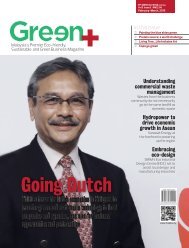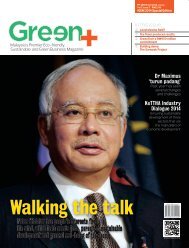Green+ Malaysia's Premier Eco-friendly, Sustainable and Green Business Magazine
SIRIM - Technology Provider
SIRIM - Technology Provider
You also want an ePaper? Increase the reach of your titles
YUMPU automatically turns print PDFs into web optimized ePapers that Google loves.
COLUMN<br />
with the conventional generation<br />
business model where instead of<br />
paying for generation it is possible<br />
to be cheaper to produce<br />
“negawatts” <strong>and</strong> removes the<br />
split incentive for a utility that<br />
also wants to maximise its sales<br />
of generated electricity.<br />
Since no tariff charge will<br />
be required to fund the obligation,<br />
there will likely be a loss<br />
of revenue scenario to the<br />
utility. To offset the loss in<br />
revenue, utilities can recoup<br />
through embracing a new business<br />
model of on-bill financing of<br />
energy efficiency. This then shifts<br />
the obligation partially to the<br />
beneficiaries. UEEOs have arisen<br />
because essentially most energy<br />
users are unwilling to invest in<br />
EE. UEEOs essentially subsidise<br />
the cost of EE, reducing paybacks<br />
down to a level where ordinary<br />
energy users are willing to invest<br />
some of their own money in a<br />
more efficient product or improving<br />
the efficiency of their existing<br />
buildings.<br />
Similar to building generation<br />
capacity, achieving large energy<br />
savings requires large investment,<br />
which the private sector<br />
is generally unwilling to make<br />
unless substantial incentives<br />
exist. A UEEO is an effective way<br />
of financing <strong>and</strong> creating these<br />
incentives.<br />
UEEOs are a relatively complex<br />
instrument <strong>and</strong> are significantly<br />
more complex to administer than<br />
the Feed in Tariff as already exists<br />
in Malaysia. Without effective<br />
administration, measurement,<br />
verification, evaluation <strong>and</strong><br />
enforcement a UEEO is unlikely<br />
to be effective. Strong commitment<br />
across all political divides is<br />
required to develop a sustained,<br />
long term UEEO.<br />
What sort of activities are<br />
undertaken to generate<br />
savings from UEEOs?<br />
Savings can be generated from<br />
either “st<strong>and</strong>ard measures”<br />
where the savings are deemed<br />
(i.e. estimated) or “project<br />
measures” which require measurement<br />
<strong>and</strong> verification of the<br />
savings achieved.<br />
Some examples of activities<br />
include:<br />
+ Efficient Water heating<br />
+ Efficient Heating <strong>and</strong> cooling<br />
+ Weather proofing <strong>and</strong><br />
insulation<br />
+ Efficient Lighting<br />
Figure 3 - The electricity market with an EEG-on-bill.<br />
+ St<strong>and</strong>by power controllers<br />
+ Efficient appliances, such<br />
as televisions, refrigerators,<br />
clothes dryers<br />
+ Efficient Pool pumps<br />
+ Efficient refrigerated display<br />
cabinets<br />
+ Efficiency refrigerator fans<br />
+ Efficient motors<br />
+ Metered baseline for commercial<br />
<strong>and</strong> industrial (any activity<br />
can be implemented, providing<br />
savings can be measured)<br />
With on-bill financing each<br />
beneficiary of the reduced<br />
upfront cost of an EE measure<br />
pays for the financing provided<br />
through an additional charge on<br />
their electricity bills.<br />
There is no need for tradeable<br />
certificates or a marketplace.<br />
Example in Figure 2 shows<br />
how this would work for the purchase<br />
of a 5 star air conditioner.<br />
Such a scheme:<br />
+ Has a set of regulator<br />
approved st<strong>and</strong>ard<br />
measures for EE fixtures. For<br />
example an air-conditioner,<br />
insulation installed in a roof<br />
cavity, installed light fitting<br />
are all fixtures. A domestic<br />
refrigerator is not a fixture.<br />
+ Has regulator approved<br />
st<strong>and</strong>ard calculations for<br />
determining the amount of<br />
financing that can be provided<br />
<strong>and</strong> the payback period.<br />
+ Attaches the on-bill payment<br />
to the electricity meter<br />
number. So that is, irrespective<br />
of whether a property is sold or<br />
changes tenants, a payment is<br />
still made, for a fixed number of<br />
payment periods.<br />
+ The payment could normally<br />
be expected to be less than the<br />
savings arising from EE.<br />
As shown in Figure 3 below,<br />
the utility company is not<br />
required to pay the EE generator<br />
any more than what it collects<br />
form the on-bill payments <strong>and</strong><br />
potentially generate income to<br />
supplement the revenue loss<br />
from the on bill financing business<br />
model. Whilst it may lose<br />
some revenue due to decreased<br />
sales of electricity, its electricity<br />
purchases from generators will<br />
also drop.<br />
Enabling Legislation<br />
Possible ways of creating the<br />
enabling legislation are:<br />
+ Incorporate it into the<br />
Electricity Supply Act (as has<br />
been done in NSW, Australia)<br />
+ Create a separate Act (as<br />
has been done in Victoria,<br />
Australia)<br />
+ Links to both these pieces of<br />
legislation are included at the<br />
end of this document.<br />
If changes were to be made in<br />
the Electricity Supply Act a new<br />
part VB could be incorporated into<br />
the Act.<br />
Alternatively it could be incorporated<br />
in Part VA – Efficient use<br />
of electricity – although a UEEO is<br />
substantially different to Part VA,<br />
<strong>and</strong> for the purposes of clarity it<br />
would be better to have it has an<br />
entirely new part.<br />
Synergy with other policies,<br />
regulations <strong>and</strong> thrusts<br />
A UEEO has substantial synergy<br />
with other proposed measures<br />
mentioned in the National Energy<br />
Efficiency Action Plan. It complements<br />
MEPS, <strong>and</strong> the expansion<br />
of MEPS. It can be used to incentivise<br />
improved whole of building<br />
performance. It can be used to<br />
drive electricity savings in both<br />
the building <strong>and</strong> industrial sector,<br />
<strong>and</strong> create significant employment<br />
opportunities in energy<br />
efficiency. A UEEO has synergies<br />
with a range of other policies <strong>and</strong><br />
regulations:<br />
+ Labelling <strong>and</strong> MEPS. A UEEO<br />
can use MEPS to allow certificates<br />
for the purchase of 5 star<br />
appliances. This leverages the<br />
labelling system<br />
+ An energy efficiency<br />
rating tool for buildings.<br />
Improvements in performance<br />
based on the rating tool could<br />
be used to award certificates.<br />
+ A national EE energy consumption<br />
database. This adds<br />
value to a UEEO by facilitating<br />
measurement <strong>and</strong> verification<br />
of savings. For example, if a<br />
lighting upgrade was undertaken<br />
<strong>and</strong> certificates claimed<br />
under a UEEO for the upgrade,<br />
the actual drop in electricity<br />
consumption at the site where<br />
the upgrade was undertaken<br />
could be identified from a<br />
national energy consumption<br />
date based. With appropriate<br />
database design, this could<br />
be used to tune the methods<br />
used to calculate savings.<br />
+ Building energy performance<br />
st<strong>and</strong>ards. Certificates could<br />
be used to incentivise performance<br />
that was measured to<br />
be better than the st<strong>and</strong>ard.<br />
+ Energy savings at large facilities<br />
(i.e. those facilities subject<br />
to the Efficient Manager of<br />
Electrical Energy regulations)<br />
– based on reductions in<br />
energy use certificates could<br />
be generated.<br />
+ Promotion of ESCOs. ESCOs<br />
could create certificates from<br />
a range of activities<br />
+ Enabling of mortgages for<br />
EE in housing. The deeming<br />
methodologies used<br />
under the scheme could be<br />
used as the basis by which<br />
financial institutions can<br />
calculate the amount they can<br />
lend for different EE features<br />
(such as high efficiency air<br />
conditioning).<br />
+ Need to allocate resources to<br />
analysing the data <strong>and</strong> fine<br />
tuning policies.<br />
green+.2014, november-december 39





